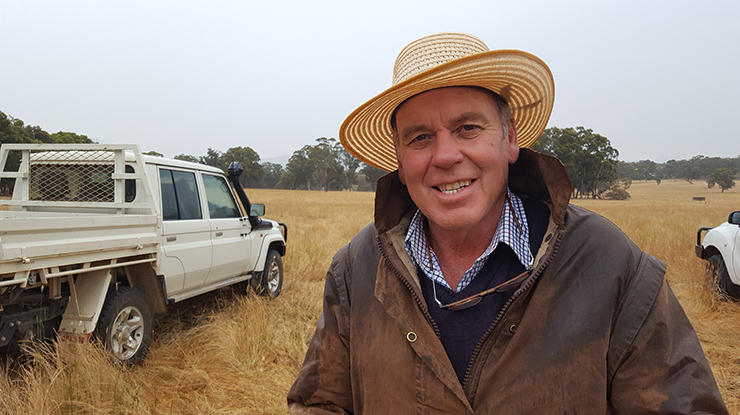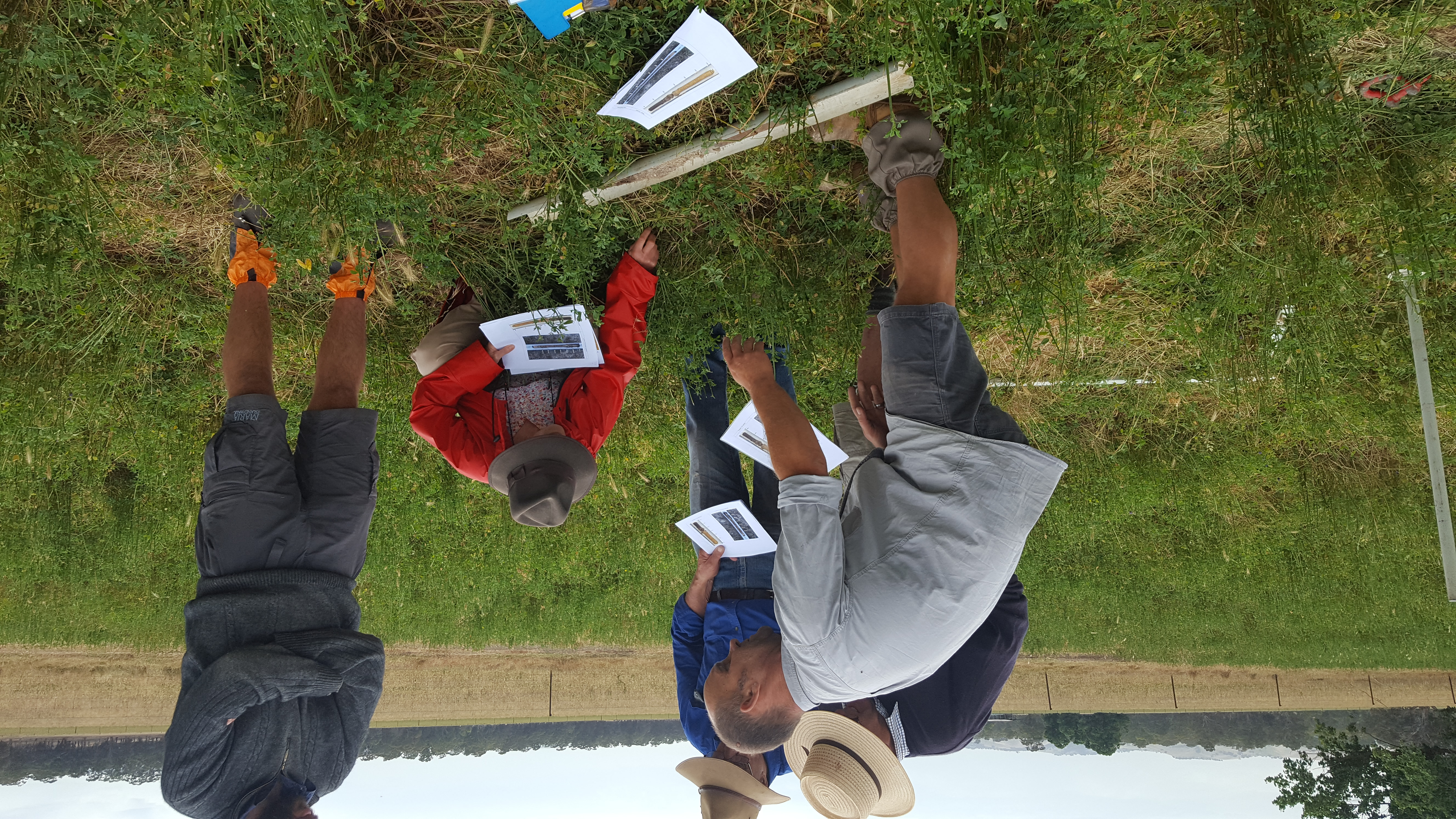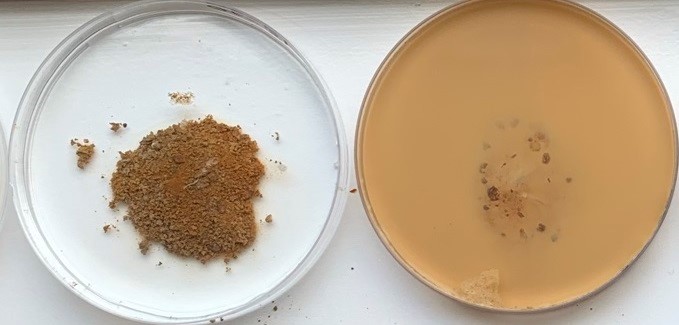
Richard Wallis (pictured above) was fully aware of the benefits of soil testing and maintaining optimal soil fertility in the top 10cm of soil, but subsoil management was more of a mystery. Here’s how he navigated the unknown to reap the rewards.
Richard and his wife Angela farm 350ha near Seymour, Victoria. They run a self-replacing Merino flock and join 50% of the ewes to Poll Dorset rams each year.
They have creek flats where lucerne has been grown for more than 40 years for grazing and hay production, and sedimentary (ironstone) hill country where pastures are mainly phalaris and sub-clover.
“My main issues about soil management are keeping the soil on the flats in good condition to keep the lucerne going, and perennial pasture persistence in the ironstone country,” Richard said.
Richard and Angela employ a regular soil testing regime (0–10cm depth) to refine the maintenance fertiliser program and prioritise any capital inputs of fertiliser or lime.
The farm has a long history of superphosphate applications, so phosphorus and sulfur levels are generally very good. Molybdenum is applied periodically, and lime is applied to the lucerne paddocks and to any hill paddocks prior to sowing.
Diagnosing the problem

Brad Costin from Agriculture Victoria showing the soil profile for the lucerne paddock
In autumn 2020, Richard first observed a one-year-old lucerne paddock, which had good establishment, contained one section looking stressed while the rest of the paddock was growing well.
As a member of the Grassland Society of Southern Australia (mid-Goulburn branch), Richard was part of the local MLA-supported Healthy Soils group, coordinated by Lisa Warn. He approached the group to investigate.
In June 2020, topsoil and leaf sample tests were taken on the two different sections of the paddock to help diagnose the problem.
Leaf analysis indicated molybdenum was low. The soil tests showed that where the lucerne was stressed, pH was lower and aluminium higher, compared with the good section. The poor section had pH 4.8 (CaCl2) and an exchangeable aluminium of 5.6%, versus the good section with pH 5.2 and aluminium of 0.05%.
“The verdict was the whole paddock required lime and the poor section a higher rate,” Lisa Warn said.
“By spring, the difference in growth was less obvious between the two sections.
“Plant growth improved in spring when there was more moisture available and possibly more roots had got past the high aluminium layers in the poor section.”
Soil profile samples
The group was studying the soil profile at depth, and they decided to further investigate.
Soil profile samples were taken from the lucerne paddock and a phalaris paddock in 2021 with the assistance of Brad Costin from Agriculture Victoria.
Workshop participants used a soil profile assessment checklist tool, developed by Lisa, to assess the soil performance at 10cm intervals down the profile. The tool outlines the appropriate test to use (field tests or laboratory tests) to allow the user to identify any constraints to plant growth and recommends appropriate management options.
“None of the group members had taken subsoil samples for pH, aluminium and cation analysis before,” Lisa said.
“They were surprised to see what was happening to pH and aluminium levels down the two different soil profiles studied.”
In Richard’s stressed lucerne paddock the topsoil pH (0–10cm) was just below the desirable range for lucerne, but the pH was much lower at the 10–20cm depth, before improving again.
“The results indicate the lime applied in the past has maintained the topsoil pH to some extent, but there is a subsoil acidity issue, and the profile may be acidifying.”
High aluminium
Aluminium levels were also high at the 10–20cm depth.
“The exchangeable aluminium level at 10–20cm depth was 35%, which is too high for a sensitive species such as lucerne,” Lisa said.
The target for lucerne is less than 5% aluminium. Aluminium will be affecting the lucerne root growth and restrict nutrient and water uptake.
“This would support the explanation that the poor section of lucerne would have been struggling because the roots were pushing through the high aluminium layer in the topsoil and the 10–20cm layer, and then growth improved once it got more roots past there,” Lisa said.
Recent research into subsoil acidity has revealed that to achieve effective lime movement down the profile, the surface pH (CaCl2) needs to be maintained at or above 5.5.
Soil-type constraints
In the phalaris paddock, the changes in pH and aluminium down the profile showed a similar trend to the lucerne paddock. The different soil type in this paddock had an additional constraint in the subsoil.

The clay subsoil in the phalaris paddock was dispersive due to the high sodium content (see cloudy dish on right).
“The clay subsoil was very dispersive due to the high exchangeable sodium percentage, which is a common problem in soils derived from sedimentary rock,” Lisa said.
A simple dispersion test on the clay subsoil sample from Richard’s phalaris pasture showed a small piece of the clay subsoil soon became cloudy after it was added to water.
“Dispersive subsoils restrict water infiltration, but it is not practical to get gypsum down there to fix the problem,” Lisa said.
“The best solution is to keep the phalaris well fertilised and rotationally graze it, like Richard is doing, to ensure it gets its roots well down. The root channels then create pathways for water movement.”
Focusing management
Richard said his experience with the Healthy Soils group was valuable and gave him focus for future management.
“My regular topsoil sampling had shown the lucerne paddock was due for another application of lime, but the subsoil test showed I really need to put more lime on the surface than I was planning, if I want to prevent the subsoil acidifying,” he said.
“After being involved with the Healthy Soils group. I think I will be able to manage soil acidity better.
“I’ll be doing more testing to see what the pH and aluminium levels are at depth and using different rates of lime. I would also like to improve how I rotationally graze the phalaris to optimise its growth and persistence.”
Lessons learnt
- Topsoil and leaf sample tests can help diagnose pasture problems.
- To achieve effective lime movement down the profile, the surface pH (CaCl2) needs to be maintained at or above 5.5.
- Dispersive subsoils restrict water infiltration, so keep phalaris well fertilised and rotationally graze so it gets its roots well down, to create pathways for water movement.
Resources
- Find more soil resources at
- Find seasonally relevant management tips and tools at








